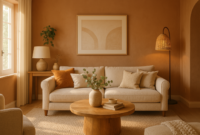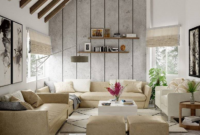Modern Interior Design: A Journey Through Style, Function, and Simplicity
Modern interior design is more than just a passing trend—it’s a transformative approach to space that reflects our evolving lifestyles, values, and aesthetic preferences. With roots that stretch back to the early 20th century and influences from art, architecture, and technology, modern design continues to redefine the way we live, work, and interact with our environments. This article explores the essence of modern interior design, its key elements, historical roots, and how to bring this timeless style into your own space.
Understanding Modern Interior Design
At its core, modern interior design is characterized by simplicity, clean lines, and a harmonious blend of functionality and aesthetics. It emerged in the early to mid-1900s, primarily influenced by the German Bauhaus school of design and Scandinavian minimalism. These movements emphasized practicality, natural materials, and the principle that form should follow function.
Today, modern design remains rooted in these ideas but has evolved to incorporate new materials, technologies, and cultural influences. It aims to create spaces that are both beautiful and livable—where every element serves a purpose and enhances the overall experience.
Key Characteristics of Modern Design
1. Minimalism and Simplicity
Modern design embraces the “less is more” philosophy. Clutter is minimized, and the focus is on essential elements that create a sense of calm and order. Furniture tends to have sleek lines and unadorned surfaces, while decorative accents are kept to a minimum.
2. Open Floor Plans
One of the hallmarks of modern interiors is the open floor plan. Walls are minimized to create a sense of flow between rooms, particularly in communal spaces like the kitchen, dining room, and living room. This approach promotes connectivity and makes even smaller homes feel more spacious.
3. Neutral Color Palettes
Color schemes in modern interiors typically revolve around neutral tones such as white, black, gray, and beige. These muted colors provide a blank canvas that allows architectural elements and furnishings to stand out. However, modern design doesn’t shy away from bold accents—splashes of color through artwork, furniture, or textiles are common and welcome.
4. Natural Materials
Wood, stone, leather, and metal are integral to modern interiors. These materials bring warmth and texture to otherwise minimalist spaces, creating balance and depth. Sustainable materials are also increasingly popular, reflecting modern concerns for environmental responsibility.

5. Clean Lines and Geometric Forms
Modern furniture and architecture feature clean, straight lines and geometric shapes. There’s a strong emphasis on horizontal and vertical elements, which contribute to a streamlined and uncluttered look. Curves are used sparingly but can add a soft contrast to angular forms.
6. Function Over Ornamentation
Every piece in a modern interior is carefully chosen for its functionality. Decorative items are limited to those that also serve a purpose—think of a sculptural lamp or an abstract painting that adds character without overwhelming the space.
Evolution of Modern Interior Design
While modern design has roots in the early 20th century, it’s important to distinguish it from contemporary design. “Modern” refers to a specific design style that originated from the modernist movement, while “contemporary” is ever-changing and reflects the design trends of the moment.
Over time, modern design has absorbed influences from mid-century modernism, industrial style, and even elements of traditional design. The result is a flexible, timeless aesthetic that can be adapted to suit a wide variety of tastes and living environments.
Creating a Modern Interior: Room by Room
Let’s take a closer look at how to implement modern design principles across different areas of the home.
Living Room
In the modern living room, comfort and style go hand-in-hand. Choose a streamlined sofa in a neutral tone and pair it with a low-profile coffee table made of wood or metal. Incorporate a few statement pieces like a bold artwork or a geometric rug to add visual interest. Large windows and natural light are key—avoid heavy drapes and opt for sheer or minimal window treatments.
Kitchen
The modern kitchen is all about clean surfaces and efficient design. Cabinetry is often flat-panel with minimal hardware, and countertops are made from durable materials like quartz or concrete. Stainless steel appliances, integrated lighting, and open shelving add to the functional aesthetic. An island with bar seating can double as a prep space and social hub.
Bedroom
Modern bedrooms are restful sanctuaries. Use a monochromatic or soft neutral palette, and keep furnishings minimal—just a bed, nightstands, and perhaps a sleek dresser. Texture plays an important role here; layer bedding, rugs, and curtains to add warmth. Built-in storage helps maintain the clutter-free vibe.
Bathroom
In modern bathrooms, simplicity meets spa-like luxury. Floating vanities, frameless mirrors, and walk-in showers with glass enclosures are popular features. Tiles in muted tones or natural stone create a calming backdrop, while under-cabinet lighting adds a subtle glow.
Home Office
As remote work becomes more common, the modern home office has grown in importance. A simple desk, ergonomic chair, and good lighting are the foundation. Keep the space visually uncluttered to support focus and productivity. Incorporate a touch of greenery or artwork for inspiration.
The Role of Technology
Modern interior design embraces technology—not just in smart home devices, but in the very materials and construction methods used. From energy-efficient lighting to sustainable building materials and integrated sound systems, technology enhances both the aesthetics and functionality of modern spaces.
Smart thermostats, voice-controlled lighting, and home automation systems can be seamlessly integrated into the design, maintaining the sleek and minimal appearance while improving convenience and efficiency.
Sustainability and Modern Design
A growing focus in modern design is sustainability. Today’s designers and homeowners are increasingly aware of their environmental impact, and modern interiors reflect this concern. This means choosing eco-friendly materials, repurposing or upcycling furniture, and designing with energy efficiency in mind.
Reclaimed wood, bamboo flooring, low-VOC paints, and energy-efficient appliances are just a few ways modern design supports a more sustainable lifestyle. Natural ventilation, passive solar design, and green roofs are also being incorporated into the architecture of modern homes.
Common Myths About Modern Design
Despite its popularity, modern interior design is often misunderstood. Let’s bust a few myths:
-
Myth 1: Modern design is cold and sterile.
Reality: While modern interiors are minimalist, they can be incredibly warm and inviting when natural materials and textures are used. -
Myth 2: It’s only for large, urban spaces.
Reality: Modern design principles can be applied to any size home, including small apartments and suburban houses. -
Myth 3: Modern means trendy.
Reality: Modern design is rooted in a century-old movement and emphasizes timelessness over fleeting fads.
How to Incorporate Modern Design into Your Home
You don’t need to start from scratch to give your home a modern twist. Here are some practical tips:
-
Declutter ruthlessly. Remove unnecessary items and focus on what truly adds value or joy to your space.
-
Update your lighting. Swap outdated fixtures for modern ones with clean lines and integrated LED options.
-
Invest in quality over quantity. A few well-made pieces will have more impact than a room full of items.
-
Repaint with neutrals. A fresh coat of white, gray, or beige paint can instantly modernize a room.
-
Mix materials. Combine wood, metal, and fabric to create a layered, sophisticated look.
-
Add greenery. Plants soften the lines and bring life into a minimalist space.
Final Thoughts
Modern interior design is a celebration of clarity, efficiency, and elegance. It transcends trends by focusing on the essentials and creating environments that are as functional as they are beautiful. Whether you’re renovating an entire home or simply refreshing a single room, the principles of modern design offer a framework that is both timeless and adaptable.
As our lives become increasingly fast-paced and digitally connected, modern interiors offer a refuge—a place of balance, mindfulness, and intention. Embracing modern design is not just about changing how your home looks; it’s about enhancing how it feels and functions in your everyday life.


